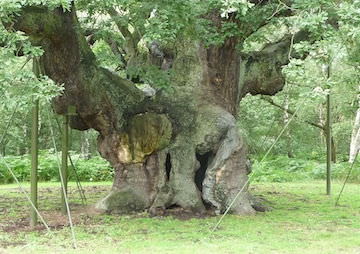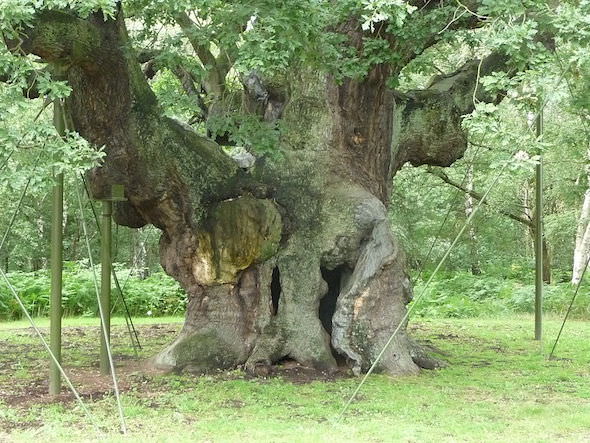Northern Forests Face Onslaught From Heat and Drought
Many Northern Hemisphere forests face destruction as climate change brings both fiercer droughts and higher temperatures.
By Tim Radford, Climate News Network

For the Major Oak in England’s Sherwood Forest, old age is not the only threat. (Immanuel Giel via Wikimedia Commons)
This Creative Commons-licensed piece first appeared at Climate News Network.
LONDON — In the long term, many of the great oak forests of Europe or the giant redwoods and pines of America may not survive. US researchers foresee potential widespread loss of the great temperate forests of both continents.
Under the combined assault of increasing global temperatures and unprecedented drought, some forests could inexorably slide into savannah or scrubland.
Constance Millar is an ecologist with the US Department of Agriculture’s Forest Service Pacific Southwest Station. She and a colleague, Nathan Stephenson of the US Geological Survey, report in the journal Science that the boreal forests of the fast-warming sub-Arctic zones are not the only imperilled woodlands.
They see climate change — driven by rising concentrations of atmospheric carbon dioxide, in turn fuelled by ever-greater fossil fuel combustion — as an emerging “mega-disturbance”: the bringer of not just longer and hotter droughts but of a new class of affliction, the unprecedented “global-change-type drought.”
This cumbersome terminology masks a spell of longer, more severe and hotter droughts that will set the circumstances for new insect pests, fresh plant diseases, invasive competitor species and more extensive and more severe wildfires.
Change imminent
Old forests matter: Dr Stephenson led a huge research team that in 2014 established – against intuition – that the oldest forest giants absorbed more carbon dioxide than young, fast-growing members of the same species.
But unless the professional and government foresters understand what is coming, stands of woodland that have for thousands of years survived periodic assault and then recovered could within decades convert to grassland, or low-growing shrub.
The scientists say that climate change and rising average global temperatures mean not just drought, but drought matched with increasing spells of prolonged heat, far more severe than anything experienced in the 20th century.
Air temperatures will mean that foliage in the canopy becomes too hot, drawing moisture from the leaf tissue at ever-faster rates. In the last century, heat would melt mountain snow in summer to supply more water to the forests in the dry seasons: in this century, most of the winter precipitation will be rain that will run off immediately. Forests will have fewer or no reserves.
Since forests are — in general — agencies that absorb atmospheric carbon, and help cool the planet, any loss can only accelerate global warming and create even more difficult conditions for the surviving woodlands.
“The emergence of mega-disturbances, forest diebacks beyond the range of what we’ve normally seen over the last century, could be a game-changer.”
“Some temperate forests already appear to be showing chronic effects of warming temperatures, such as slow increases in tree deaths”, said Dr Stephenson. “But the emergence of mega-disturbances, forest diebacks beyond the range of what we’ve normally seen over the last century, could be a game-changer for how we plan for the future.”
Nor is there any guarantee that the end of a drought will permit young trees to recolonise the burnt, parched and blighted landscape: fast-growing grass and shrub species will get there first and block any regrowth.
Since forests support not just ecosystems and species that are beautiful for their own sakes and valuable both as resources and as tourist attractions, but also deliver “services” in the form of water management and global air-conditioning, human settlements will soon feel their loss.
Such research evokes the big picture. It embodies not just prediction but warning: if governments, state authorities and communities know what could happen, they can take steps to identify and manage the most vulnerable forests in ways that might increase resilience.
But the message is that unprecedented threat will require unprecedented action. “While we have been trying to manage for resilience to 20th century conditions, we realise now that we must prepare for transformations and attempt to ease these conversions,” said Dr Millar.
Your support matters…Independent journalism is under threat and overshadowed by heavily funded mainstream media.
You can help level the playing field. Become a member.
Your tax-deductible contribution keeps us digging beneath the headlines to give you thought-provoking, investigative reporting and analysis that unearths what's really happening- without compromise.
Give today to support our courageous, independent journalists.






You need to be a supporter to comment.
There are currently no responses to this article.
Be the first to respond.